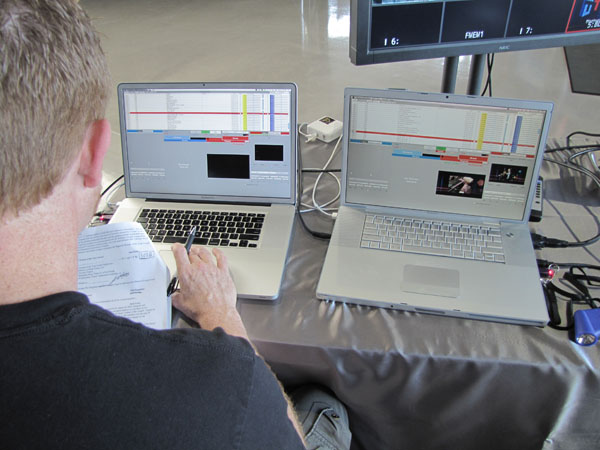Review: Panasonic AV-HS400N HD Video Mixer
HD video mixers aren't cheap, but they do offer amazing functionality inside compact boxes. I put Panasonic's AV-HS400N through its paces during an awards ceremony. I found much to like, and a few minor issues, and look forward to technologies like this becoming more affordable in the years to come.
Laptops and Format Issues
With the setup we had on this shoot, our laptop feeds were passing through a Convergent Design HDMI/HD-SDI converter on their way into the mixer. We weren't actually using two laptops at the same time, but they were mirrored devices so that if one crashed, or got hung up, the operator could move one foot to his left, click the same clip, I'd change inputs, and we'd continue on our way. Computers have a habit of crashing at the most inopportune moments, so we've learned to set up redundant backups ready to go from the outset.

Our two laptops, functioning as mirrored devices
Both computers used special software to play out video clips, animated titles, and static slides like a program, sometimes stopping, sometimes continuing through to the next element. This way, the second monitor output of the laptops never showed the desktop--they were dumbed-down to act like a deck, but one that could handle playback of different types of media.
We had the entire system set up to 720p, but one of the laptops was just not sending a feed that the HS400 would show. We tried several things to debug the problem, and the separate monitor we were using for the AUX feed again proved invaluable because it would display the format of the HD-SDI feed when you plugged the cable in the back of the monitor. There, we discovered that the second computer was sending a 1080i60 feed. The HS400 requires that every SDI input be the right format coming in, but it never indicates what the problem is when you see nothing on the mixer's multiviewer. To fix the problem, we had to get the laptop to change the HDMI output to the Convergent Design converter.
Even that took a little more debugging than we anticipated. The playback software locked all system settings so you couldn't change the second video output format while the playback software was running. After we figured that out, we rebooted the computer just to be on the safe side and ensure it was all in the right format from the ground up.
1080i60 vs. 720p60
Then, the producer of the event asked why we weren't doing the show in 1080i60 instead of 720p60. I explained that I'd been told that the JVC cameras were recording an ISO feed and they record only 720, not 1080. But the producer informed us that the ISO recording part of the production was scrubbed and he asked everything to be switched to 1080i60.
We endeavored to change both cameras and both of the laptops to 1080i60. The Blu-ray playback was already 1080i60, and the HS400 automatically scaled any analog input to the standard the mixer was set to. However, even after we got both laptops up to 1080, we had trouble with the cameras. For some reason, the output of both cameras would not show up in the mixer, even when their format was determined to be correct when we connected them directly to the AUX monitor. So we dropped everything back to 720p60.
Dealing With Distortion in the Frame
Then, we started to notice a repetitive glitch in the video from the Convergent Design converters. Again, we used the AUX monitor with a direct connection and the format was correct, and we never saw a glitch on a direct connection, but when connected to the HS400, every 20 seconds or so, there was some sort of distortion in the frame, no matter if the video from the laptop was playing or not.
We determined that it must be some sort of timing issue between the devices, which could have been solved if the HDMI/SDI converter boxes had a Genlock input so we could sync them with the mixer. The alternative solution-and the one that we all agreed would be implemented for the next multicam production-would be for the studio to purchase the optional AV-HS04M3 dual DVI input board. This device is pricey in and of itself, but it would eliminate the MiniDVI-to-HDMI adapters on the laptops and the HDMI-to-HD-SDI converters we were having issues with. Plus, it would convert to any format the mixer was set to, reduce the number of potential points of failure in the entire setup, and free up two HD-SDI inputs for cameras. With all those benefits, the cost is justified.
Because the producer had told us he wasn't recording any ISO feed, I asked him if the he wanted us to record a feed in addition to the IMAG feed. To accomplish this, in essence, we could swing a camera around and get reaction shots and cutaways-things that don't need to be on IMAG, but greatly facilitate editing. The HS400 could handle three feeds, which would come in handy if you ever needed to dissolve or create a picture-in-picture with the A and B buses of the mixer. With the internal matrix router, you can assign any input, AUX, preview or program to either of the two HD-SDI outputs. For this show, that meant I could assign preview to a separate output and record that, but the producer decided that it was too much trouble to try and punch three different shows.